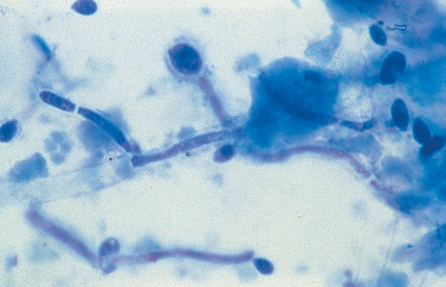Difference between revisions of "Avian Medicine Q&A 16"
Jump to navigation
Jump to search
(Created page with "<br style="clear:both;" /> {| align="left" width="100%" style="background-color:#04B4AE" |- | align="center" | 90px|Mansonlogo | align="left" | This ques...") |
|||
| (One intermediate revision by the same user not shown) | |||
| Line 3: | Line 3: | ||
|- | |- | ||
| align="center" | [[File:Manson_logo.gif|90px|Mansonlogo]] | | align="center" | [[File:Manson_logo.gif|90px|Mansonlogo]] | ||
| − | | align="left" | This question was provided by [[:Category:Manson|Manson Publishing]] as part of the [[OVAL Project]]. See more [[ | + | | align="left" | This question was provided by [[:Category:Manson|Manson Publishing]] as part of the [[OVAL Project]]. See more [[Category: Avian Medicine Q&A|Avian Medicine questions]] |
|} | |} | ||
<br><br><br> | <br><br><br> | ||
| Line 15: | Line 15: | ||
There is no apparent inflammatory response. The yeast and hyphae are compatible with a severe yeast infection, most likely candidiasis, involving the ingluvies. | There is no apparent inflammatory response. The yeast and hyphae are compatible with a severe yeast infection, most likely candidiasis, involving the ingluvies. | ||
| − | |l1= Candidiasis | + | |l1= Candidiasis |
|q2= What therapy would you recommend for this condition? | |q2= What therapy would you recommend for this condition? | ||
|a2= An antifungal drug is indicated for the treatment of candidiasis. The presence of hyphae is suggestive of invasion of the mucosa by the yeast and the potential for a systemic infection. | |a2= An antifungal drug is indicated for the treatment of candidiasis. The presence of hyphae is suggestive of invasion of the mucosa by the yeast and the potential for a systemic infection. | ||
Therefore, a systemic antifungal – e.g. itraconazole PO for 7 days – should be used along with a local or topical antifungal, e.g. nystatin BID or TID for 7–10 days. | Therefore, a systemic antifungal – e.g. itraconazole PO for 7 days – should be used along with a local or topical antifungal, e.g. nystatin BID or TID for 7–10 days. | ||
| − | |l2= Candidiasis | + | |l2= Candidiasis |
|q3= What predisposing conditions lead to the development of this condition in hand-fed chicks? | |q3= What predisposing conditions lead to the development of this condition in hand-fed chicks? | ||
|a3= Immunosuppressive conditions and trauma to the ingluvies lead to the development of candidiasis. | |a3= Immunosuppressive conditions and trauma to the ingluvies lead to the development of candidiasis. | ||
Predisposing factors include hypothermia, feeding a formula that is too cold or too hot, poor nutrition, antibiotic therapy and systemic illness from other causes. | Predisposing factors include hypothermia, feeding a formula that is too cold or too hot, poor nutrition, antibiotic therapy and systemic illness from other causes. | ||
| − | |l3= Candidiasis | + | |l3= Candidiasis |
</FlashCard> | </FlashCard> | ||
| Line 31: | Line 31: | ||
rect 0 0 860 850 [[Avian Medicine Q&A 17|Next question]] | rect 0 0 860 850 [[Avian Medicine Q&A 17|Next question]] | ||
desc none}} | desc none}} | ||
| − | [[Category: Avian Medicine Q&A]] | + | [[Category: Avian Medicine Q&A]] [[Category:To Do - Manson]] |
Revision as of 13:51, 29 June 2011
| This question was provided by Manson Publishing as part of the OVAL Project. See more |
A three-week-old, hand-fed Moluccan cockatoo chick (Cacatua moluccensis) was presented with a three-day history of delayed emptying of the ingluvies. The chick weighed 186g. An aspirate of the ingluvies was performed for cytological evaluation.
| Question | Answer | Article | |
| What cytodiagnosis do you make? | The Wright’s-stained smear reveals many oval yeast and hyphae.
There is no apparent inflammatory response. The yeast and hyphae are compatible with a severe yeast infection, most likely candidiasis, involving the ingluvies. |
Link to Article | |
| What therapy would you recommend for this condition? | An antifungal drug is indicated for the treatment of candidiasis. The presence of hyphae is suggestive of invasion of the mucosa by the yeast and the potential for a systemic infection.
Therefore, a systemic antifungal – e.g. itraconazole PO for 7 days – should be used along with a local or topical antifungal, e.g. nystatin BID or TID for 7–10 days. |
Link to Article | |
| What predisposing conditions lead to the development of this condition in hand-fed chicks? | Immunosuppressive conditions and trauma to the ingluvies lead to the development of candidiasis.
Predisposing factors include hypothermia, feeding a formula that is too cold or too hot, poor nutrition, antibiotic therapy and systemic illness from other causes. |
Link to Article | |
